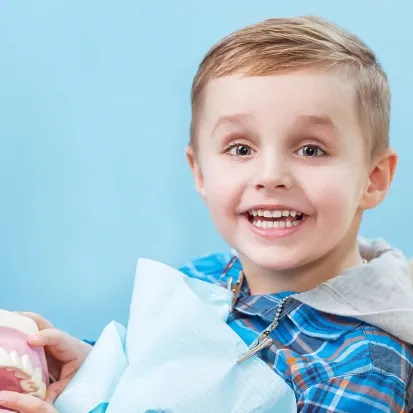Pulp Treatment for Primary Teeth
A toothache in your child’s mouth is often caused by a cavity. But when your child still has baby teeth, the pain may signal something worse: a tooth infection. Primary teeth are naturally weaker than permanent teeth and more susceptible to disease and infection. To make sure your kids’ teeth are well cared for, maintain regular cleaning appointments and call the experts at Tiny Smiles Pediatric Dentistry — in Woodbridge, NJ, on the Lower East Side of Manhattan and in Harlem, NY — when your child may need a pulp treatment for primary teeth.



What Is a Pulp Treatment?
A pulp treatment is a dental procedure to treat dental trauma to the soft pulp of a tooth. Pulp is found in the inner cavity, inside the root canal of a tooth, which contains soft tissue, nerves and blood vessels. Through those blood vessels, the pulp provides the tooth with oxygen and necessary nutrients. If damaged, the tooth can die.
As the pulp isn’t visible to the naked eye, it’s difficult to associate pain to pulp problems. Know what to do in the event that you need an emergency or urgent care pediatric dentist for any tooth-related pain. Tiny Smiles Pediatric Dentistry — in Woodbridge, New Jersey, Harlem and the Lower East Side in Manhattan — offers restorative treatments that include fillings to address cavities and pulp treatments for damaged teeth.
Why Do Primary Teeth Need a Pulp Treatment?
Even though primary teeth eventually fall out, they need the same type of preventative dentistry treatments as adult teeth. Primary teeth are more vulnerable because the enamel of young teeth is thinner. This makes it easier for bacteria to penetrate the enamel shell and reach the dentin and pulp.
Dental caries is the most common cause for pulp-related pain. The sad fact is that 42 percent of small children get cavities in their primary teeth. Facial traumas, like a hit from a ball or a bad fall during playtime, can fracture a tooth, leading eventually to an infection.
A pulp treatment for primary teeth targets the infected tooth first, treating it before trying to restore and save the integrity of the tooth. If you don’t seek immediate dental treatment for your child, it may lead to long-term issues. For example:
How Is this Pediatric Procedure Done?
During your child’s first visit at Tiny Smiles Pediatric Dentistry, your dentist assesses the pain. Your child may complain of constant, unexplained pain, especially during the night. Swelling or redness develops around an infected tooth, along with temperature sensitivity in the tooth. There may also be signs of premature loosening of the tooth.
To calm your child, the dentist may opt for a sedative to ease the pain and decrease any dental anxiety before the procedure. In most pulp infection cases, pulp treatment for primary teeth depends on the tooth. Techniques include:
Pulp capping. This method treats the infected pulp like a cavity. The infected part of the tooth is removed, and a filling material, usually a white composite resin, is added to protect the tooth and its pulp.
Pulpotomy. This method saves the tooth by preventing further decay. It works similarly to a root canal treatment, where the infected pulp is removed while maintaining the health of the rest of the tooth. A medicated agent is added into the root canal of the tooth to prevent further bacteria. Finally, a white crown is placed over the tooth to minimize potential fractures.
Pulpectomy. This method is employed for severe cases where the entire pulp and the root canals are infected. The dentist needs to remove all the pulp and then cleans the root canals. A bio-compatible material is then placed over the exposed pulp before a material like a BPA-free filling is placed in the tooth. A crown is added for strength and structural support.
The number of visits to the dentist depends entirely on the pulp treatment for primary teeth. For the pulpectomy, you may need to take your child several times as the tooth needs time to heal before the next steps. The success rate for a pulpotomy is 85 percent and for a pulpectomy 77 percent. If the pulp capping fails, one of the other procedures happens next.

What Can I Expect after My Pulp Treatment?
Your child becomes pain-free immediately after the procedure. Follow any post-operative care instructions. Also, make sure your child doesn’t brush the affected teeth after the procedure.
It’s normal for some temporary fillings to break between appointments. If these restorations fail, immediately call your dentist at Tiny Smiles Pediatric Dentistry. When your child complains of a toothache, schedule an appointment with the best pediatric dentists in NYC and NJ.
